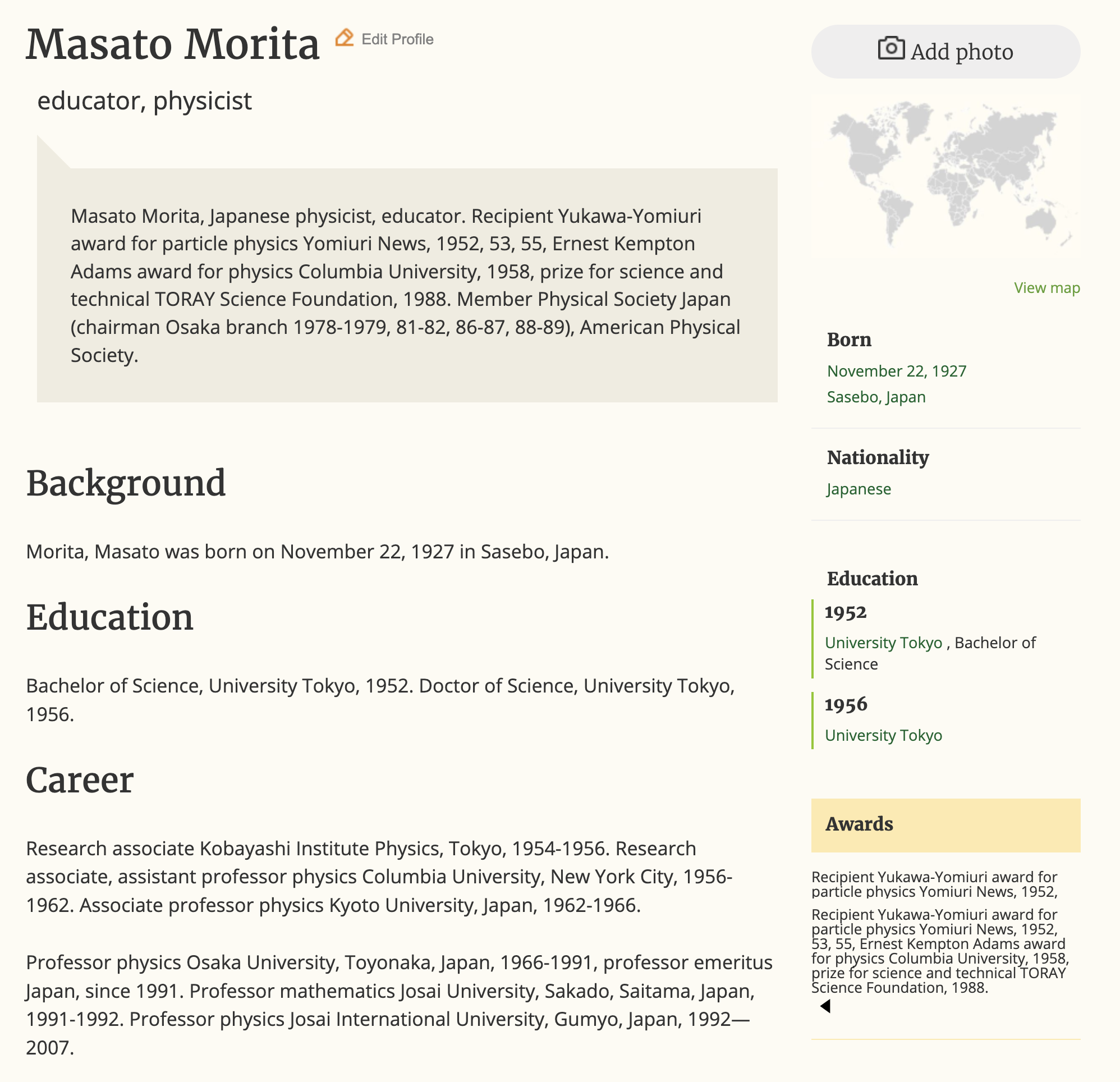Columbia research fellow Masato Morita described Rustad-Ruby post-deadline presentation
We have seen how physics in the post-war world was an international community, even embracing researchers from recently defeated Axis countries. The physics group at the University of Tokyo and the Kobayashi Institute of Physics was on top of the latest developments in beta decay theory and experiment in the early 1950s.
In April 1953, graduate student Masato Morita published calculations of electron-neutrino angular correlation functions taking into account the effect of nuclear charge. On the Electron-Neutrino Angular Correlation by Masato Morita appeared in English in April 1953, Vol. 9, No. 4 of Progress of Theoretical Physics.
One reason that paper is notable is that it takes note of the recently announced Rustad-Ruby result favoring the tensor interaction. Another is that Morita, after finishing his doctorate in 1956, would come to Columbia University to study the implications of parity non-conservation on beta-decay transitions.
He and his wife Reiko Saito Morita, also a physicist, found themselves closely in the orbit of C.S. Wu. Morita was first a research associate at Columbia, then recipient of the department’s 1958 Ernest Kempton Adams fellowship, and then an assistant professor across his six years at Columbia, before he returned to Japan in 1962.
Morita’s first paper with Columbia University attribution, authored together with R.S. Morita, First-Forbidden Transitions in Parity-Nonconserving Beta Decay, was submitted to Physical Review in September 1957, though it did not appear until March of the following year.
The aim of the paper was to generalize their previous work on beta-gamma directional correlations of first-forbidden transitions in beta decay with the new understanding of parity nonconservation. I will just quote briefly from the acknowledgements.
The authors would like to express their sincere thanks to Professor W. W. Havens, Jr., for his hospitality, to Professor C. S. Wu and Dr. M. Yamada for valuable discussions, and to many authors who have sent us their preprints. One of us (M. M.) is deeply indebted to the Nishina Memorial Foundation for a grant, which made his stay in the United States possible.
The next publication by the two Moritas, together with another Japanese physicist working in the U.S., M. Yamada, was Possible Experiments for Determination of Beta Interactions. It was received by Physical Review on February 24, 1958, and published on July 1, 1958. You can tell from the acknowledgments that the Morita’s have settled in more deeply in the department, and that it is Wu who is directing their work.
The authors would like to express their sincere thanks to Professor W. W. Havens, Jr., and Dr. K. Way for their hospitality, to Professor C. S. Wu for suggesting this problem, to Dr. L. J. Lidofsky and Dr. A. Schwarzschild for valuable discussions. One of us (M. M.) is deeply indebted to Columbia University for a fellowship, and to the Nishina Memorial Foundation for a grant.
Without getting into the substance of the paper, it is most interesting for us because it gives the best summary of the otherwise missing post-deadline paper of Rustad and Ruby. If you recall, they had given the paper in January at the American Physical Society meeting at the New Yorker Hotel. Because it was a post-deadline submission, no title or abstract was recorded and we have had only the most general of descriptions.
But in this paper by the Moritas and Yamada, a footnote provides a fuller idea of what they actually said.
2 The experimental data on the beta-(recoil nucleus) angular correlation of the neutron [J. M. Robson, Phys. Rev. 100, 933 (1955)]; He6 [B. M. Rustad and S. L. Ruby, Phys. Rev. 97, 991 (1955); Szalay et al., Padua Conference, 1957 (to be published)]; Ne19 [Maxson, Allen, and Jentschke, Phys. Rev. 97, 109 (1955); M. L. Good and E.J.Lauer, Phys. Rev. 105, 213 (1957); W.P. Alford and D. R. Hamilton, Phys. Rev. 105, 673 (1957)j; Ne23 [R. W. Ridley, Nuclear Phys. 6, 34 (1958)]; and A35 [Hermansfeld, Maxson, Stahlin, and Allen, Phys. Rev. 107,641 (1957)] may all be compatible with the same values of coupling constant ratios if certain corrections to the experimental results on He6 are taken into account. (B. M. Rustad and S. L. Ruby, postdeadline paper presented at the New York Meeting of the American Physical Society, 1958).
So we learn that they introduced certain unspecified corrections to the experimental results, which would make their conclusion consistent with the other experiments, i.e. that the interaction is vector axial and not tensor.
We don’t know the precise corrections proposed—if they addressed the issues over pressure gradient and effective source volume raised in Wu’s re-examination—but it seems clear that Rustad and Ruby acknowledged that their original tensor interpretation was not correct.
While writing this, I found another publication by Morita, Theory of Beta Decay (Supplement of the Progress of Theoretical Physics, No. 26, 1963) that also addresses the post-deadline APS paper. Morita writes:
[T]hey expressed their opinion that certain experimental uncertainties make the interpretations originally made from their results questionable.

